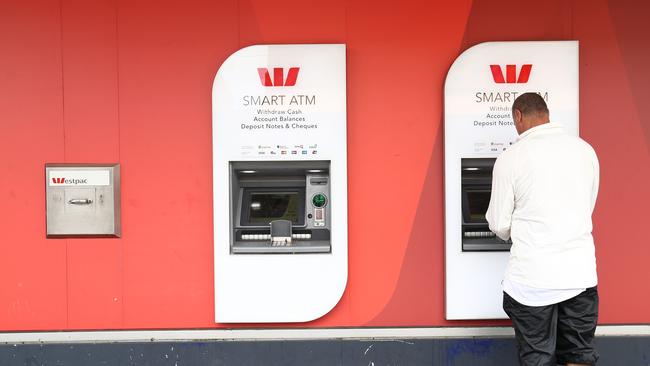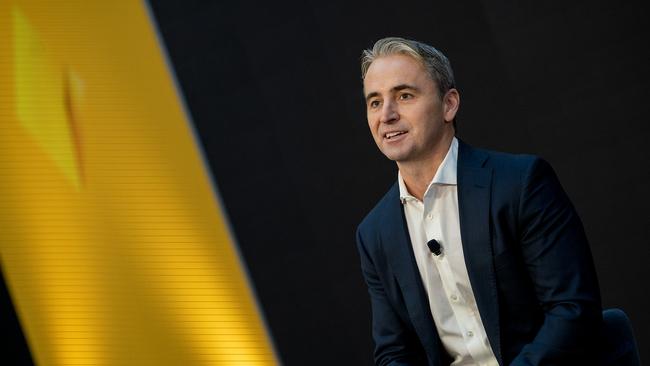Pressure on bank profitability to ease with looming rate hike on Tuesday
Interest margins will fatten for the heavyweight banking industry after the expected second consecutive monthly hike in the cash rate on Tuesday.

A second consecutive monthly hike in official interest rates on Tuesday will further ease the unrelenting pressure on major-bank profitability in recent years.
Credit Suisse bank analyst Jarrod Martin said he expected major-bank net interest margins (NIM) to expand 15-20 basis points as the Reserve Bank lifted the cash rate from its record low of 10 basis points to 1.5 per cent.
“NIMs will get close to two per cent from their current level of less than 1.9 per cent,” Mr Martin said.
“So the balance at the moment favours the upside, but the latter stages (of the cycle) are not as good for bank share prices because of asset-quality considerations, such as the impact on house prices.”
Depressed industry NIMs from the 11-year downward trajectory in the cash rate have been the main brake on major-bank profit growth, with the recent half-year profit reporting season no exception.
According to KPMG, the average NIM slumped 13 basis points from the 2021 financial year to 1.75 per cent.
Hessel Verbeek, banking strategy lead at the professional services firm, said the main drivers of eroding NIMs were low lending rates in a very competitive market, and strong demand for low-margin fixed rate mortgages.
This was only partly offset by lower funding costs from near-zero deposit rates.
“The impact of an extended period of low interest rates is deeply baked into NIMs,” Mr Verbeek said.
The RBA will announce its monetary policy decision on Tuesday after its June board meeting, with market expectations ranging from a standard 25 basis-point increase to as much as 50 basis points.
Any tightening in policy towards the higher end of the scale would signal a determination by the central bank to break the back of inflationary expectations.
Westpac chief economist Bill Evans said the RBA, by announcing a 40 basis-point adjustment to 0.75 per cent, would be fully unwinding the emergency 2020 rate cuts to cushion the economic impact of Covid-19.
Further, bigger rate increases at the early stage of the cycle were “good policy”.
“Better to move decisively in the early stages of the cycle when it is clear rates are well below neutral than later in the cycle when there is a risk that policy moves too quickly into contractionary territory,” Mr Evans said.
“An early decisive move also sends a clear signal that the Bank is committed to its inflation objective and will likely impact inflationary expectations in the community.”
AMP head of investment strategy and chief economist Shane Oliver also said a 40 basis-point tightening was likely, although there was a risk that the RBA would go even higher to 50 basis points.
Either way, Dr Oliver said the cash rate by year’s end would be in the range of 1.5-2 per cent, with a peak of 2-2.5 per cent in 2023.
UBS forecast a 25 basis-point increase, while acknowledging the risk of a 40 basis-point increase.
At Commonwealth Bank’s third-quarter profit announcement last month, chief executive Matt Comyn reaffirmed that every 25 basis-point rise in the cash rate translated to a four basis-point NIM expansion.
“That’s purely just on the deposit side, and then of course there’s offsetting factors from funding,” Mr Comyn said.
“But the outlook for margins looks good for the financial year, and looks better for the 2023 financial year.”

For CBA, every point of net interest margin equates to an extra $80m of net interest income, with the bank reporting $18.8bn of net interest income in 2021.
RateCity research director Sally Tindall said the RBA was likely to lift the cash rate this month “before the ink has dried on the May increase”.
“With petrol and grocery prices continuing to shoot up, the case for a 0.4 percentage-point hike is strong,” Ms Tindall said.
“Central banks across the world are struggling to get on top of inflation, and the RBA does not want to be one of them.”
If the cash rate rose to 1.75 per cent by Christmas, the average home loan customer with $500,000 owing could see their monthly repayments rise by $442.
They would be paying an extra $652 a month by Christmas 2023.
While the outlook for major-bank NIMs is positive, Citi analyst Brendan Sproules warned in a note on Monday that funding costs were starting to rise, albeit with a negligible impact on NIMs up to this point.
Mr Sproules pointed to a range of factors, including a steeper yield curve, more debt issuance (from Covid-inspired lows due to cheap central-bank lines) and lower investor demand.
This had resulted in the pricing of high-rate sensitive funding sources moving “noticeably higher” in the space of two months.
“While this is likely to signal the end of the era of ultra-cheap funding for all banks, we see very little near-term impact on the major bank NIMs,” he said.






To join the conversation, please log in. Don't have an account? Register
Join the conversation, you are commenting as Logout